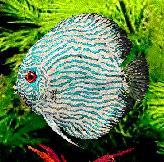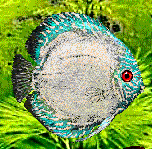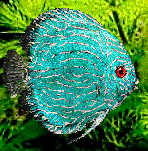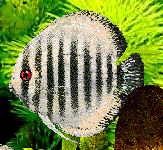Hey! I know this is a little unusual but I’m going to crack open FisherMan, a third-party fish and tank editor for Aquazone. What’s going to happen? It’s really anybody’s guess.
Anyway. I took my existing discus tank and decided to make a duplicate to play with today. I opened up Fish tank, hit the Splicing button and changed all of the values to 1.
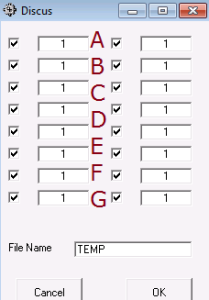 I realize it looks like I’ve only labelled the first row but think of the genes this way. Discus are diploid organisms. This means that they’re allowed to have dominant and recessive genes. If I make them completely homozygous, it’s easier to tell which genes produce which phenotype.
I realize it looks like I’ve only labelled the first row but think of the genes this way. Discus are diploid organisms. This means that they’re allowed to have dominant and recessive genes. If I make them completely homozygous, it’s easier to tell which genes produce which phenotype.
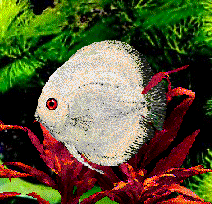 Changing all of the values (A-G) to 1 produces Albino fish. I still have no idea what lines do what, but if the discus genes are anything like the guppies, the way their colors come out will depend on some sort of base gene. For now, I’m going to go down the lines and see what happens when I change each line.
Changing all of the values (A-G) to 1 produces Albino fish. I still have no idea what lines do what, but if the discus genes are anything like the guppies, the way their colors come out will depend on some sort of base gene. For now, I’m going to go down the lines and see what happens when I change each line.
A
A 50
Changing line A seems to give the fish a striped halo. The lines are in light blue. There are no other changes to the fish. Trying the middle ground (25) between a naked fish and this halo doesn’t produce anything. So far, we’ve seen this pattern in Spartacus
A 100 (max)
Here, we have a fish totally covered in stripes. Changing the value doesn’t seem to affect the color at all, just the intensity of the fish’s stripes. I’ve seen this particular pattern in my two female discus.
Now, let’s take the stripes off of these fish and see what happens when I change the values of the next line.
B
B 1-100
The fish doesn’t look any different from the Albino fish above. This got me curious about the relationship between B and A and if there was one.
A 50 – B 50
Changing B to 50 seems to produce thicker stripes! Changing the value to 100 has the same result. What about when we change A to 100 for full stripes?
A 100 – B 50
Seeing this has revealed quite a bit to me. It might look, to some, like the base color would be where the light blue is and the white would be accents, but after learning what I have so far, you could consider the base color to be covered by the stripes. Changing B to 100 produces the same result.
So far, we’ve learned that A affects striping and B affects the strength or intensity of those stripes.
Let’s move on to C.
C
C 50
Here’s where past research comes in handy for me. Once I learned that line C controlled the vertical bars on these fish, I rembered a page I read on the matter. This line and G control the intensity of the bars but it takes a value of 50 before C produces a single full bar. If you would like to read that page, you’ll find it here. We’ll learn more about C and G once we reach G.
C 100
To my surprise, C100 gave me full bars! I have a theory now about how G affects the intensity of C now. I’m guessing that C 50 is the base for G and values G 50 and G 100 affect the intensity of C where C 100 throws full bars regardless of G. We’ll test that theory once we reach that line, though.
Learning what I can about three lines of Discus’ genetic code is enough for me for now and I feel I need to save some for next time anyway. See you with the rest soon!

